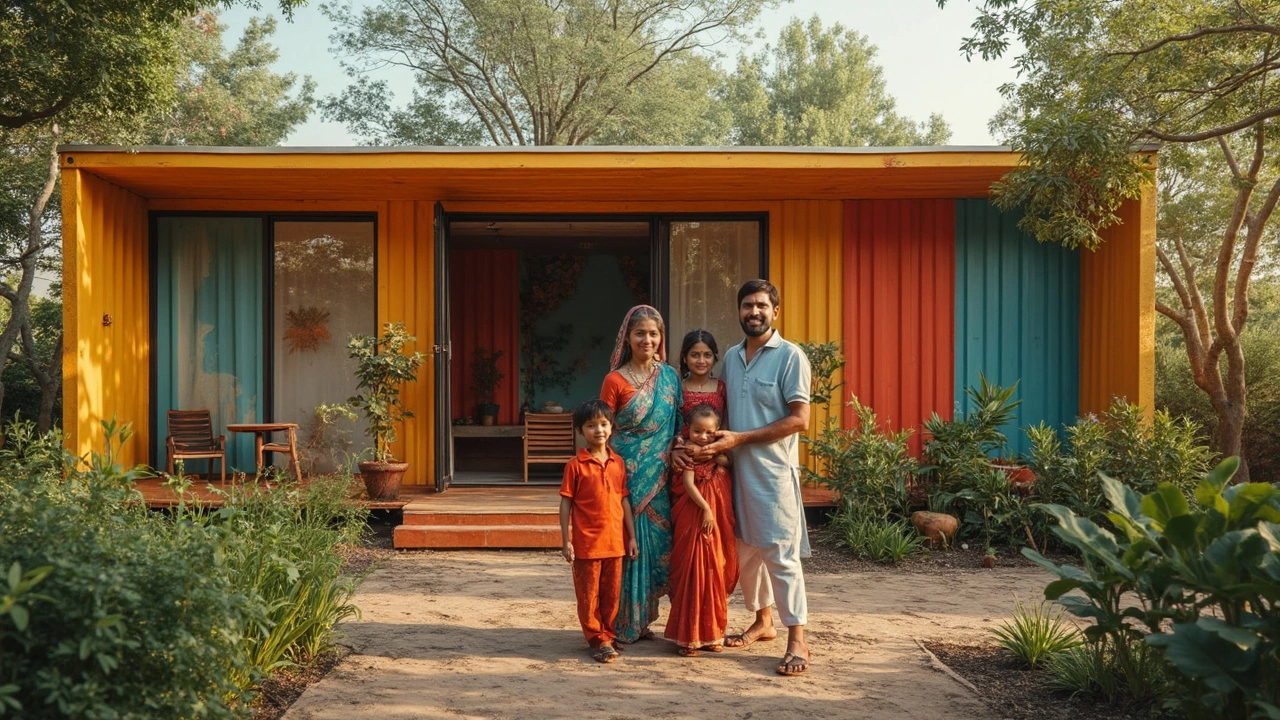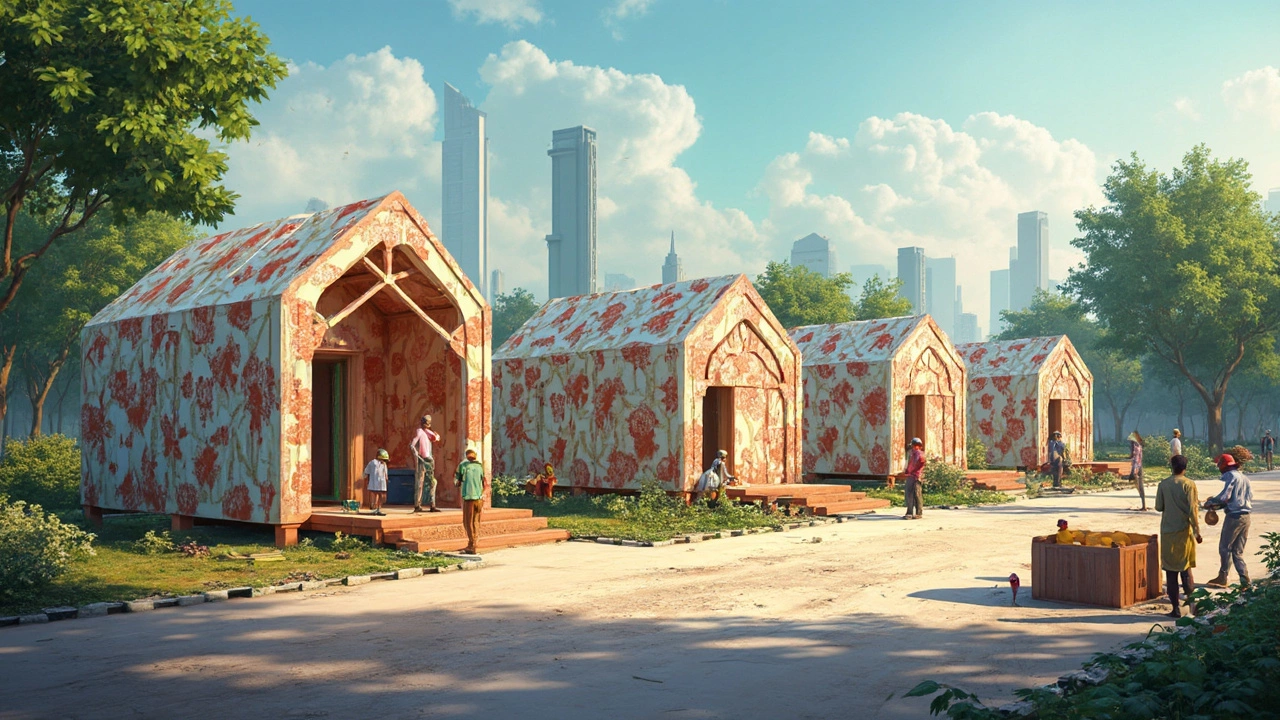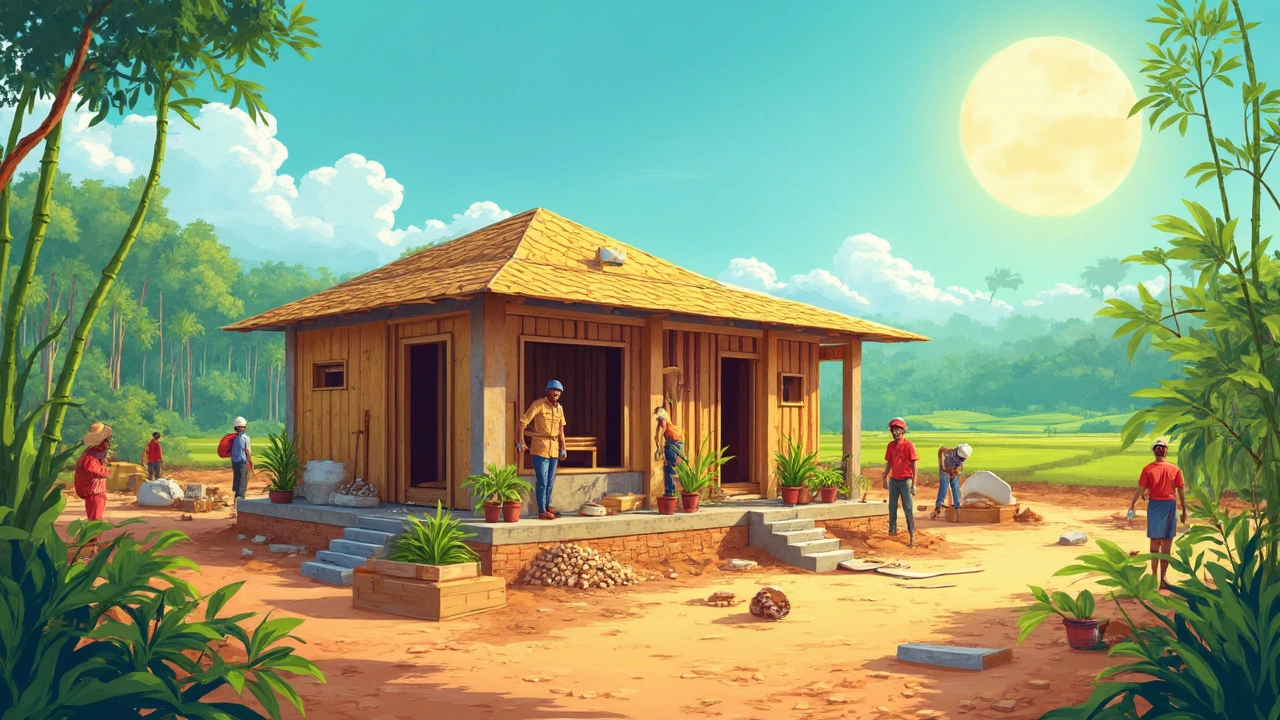Building a new home without breaking the bank isn’t a pipe dream anymore. With plenty of affordable methods popping up, it’s no longer just about cinder blocks and drywall. Curious about the most economical approach? Let’s dig into some options that won’t have you living on a diet of ramen till retirement.
First up, let’s chat about prefabricated homes, or 'prefabs' as the cool kids call them. These aren't the old rickety mobile homes of yore. Now, they're sleek, stylish, and quick to assemble, which makes them super cost-efficient. Imagine having your walls and roof delivered like a flat-pack IKEA wardrobe. That's prefab for you!
And if you like to think outside the box (literally), consider the shipping container trend. These hefty containers might once have been loaded with who-knows-what, but now they're being transformed into some of the trendiest homes around. Durable? Check. Eco-friendly? Double check.
- Understanding Cost-Effective Materials
- The Rise of Prefabricated Homes
- Shipping Containers: Not Just for Freight
- Natural Materials with a Modern Twist
- Comparing the Best Methods for Your Needs
Understanding Cost-Effective Materials
Choosing the right materials can be a game-changer when you're looking to build on a budget. One of the biggest ways to keep costs down is to use locally sourced materials. They don’t just cut down on shipping costs; they also support the local economy and often come with a smaller carbon footprint.
Concrete and Steel
Concrete is a strong contender in the world of cost-effective building. It's versatile, durable, and better yet, it's one of the most affordable building materials out there. Steel might cost a bit more upfront, but its durability and resistance to termites and rot can save you money on repairs in the long run.
Bamboo and Straw Bales
For those who lean towards eco-friendliness, consider bamboo and straw bales. Bamboo grows like nobody's business—some types can even grow up to three feet in 24 hours! It’s lightweight yet strong, and it gives a unique aesthetic touch. On the other hand, straw bales provide excellent insulation, keeping heating and cooling costs in check.
Recycled and Upcycled Materials
Don't underestimate the power of recycled and upcycled materials. Using reclaimed wood or repurposed bricks not only saves money but also adds a character that you can’t always get with new materials. Plus, it’s an environmentally savvy choice.
To help you weigh the options, here's a quick look at how these materials compare in terms of cost and sustainability:
| Material | Approximate Cost | Sustainability |
|---|---|---|
| Concrete | Low | Moderate |
| Steel | Medium | High |
| Bamboo | Low | Very High |
| Straw Bales | Very Low | High |
| Recycled Wood | Varies | Very High |
These materials show promise for those looking to build new without blowing the budget. With thoughtful choices, you can create a cost-effective new build that's both economic and sustainable.
The Rise of Prefabricated Homes
Imagine building a house without the stress of traditional construction chaos. Prefabricated homes—those nifty structures assembled off-site and delivered to your plot—are changing the game. Fast, efficient and relatively affordable, they’re gaining traction among savvy homeowners keen on minimizing costs without losing quality.
One of the big appeals of prefabricated homes is speed. Typically, these homes can be built and installed in half the time it takes to complete a conventional build. That’s a huge win if you're in a hurry to put a roof over your head. Plus, less time building usually means less money spent—that's the kind of math we can all get behind!
Efficiency Meets Custom Design
A common misconception is that prefabs are cookie-cutter and bland, but let’s bust that myth. You can find options ranging from sleek, modern aesthetics to charming, cottage-inspired designs. The ability to customize your space with different layouts, finishes, and materials means your prefab can match your style without an extravagant price tag.
Some companies even offer energy-efficient and sustainable options, enhancing the eco-credentials of your new build. It's like getting a dual bonus: saving on energy costs and feeling good about reducing your carbon footprint.
Not Just a Quick Fix
Prefabs aren't just a temporary solution either. They are built to last, often adhering to the same building codes as site-built homes. That means you get durability along with your savings. One critical factor is choosing a reputable manufacturer who uses quality materials and has a sound track record.
- Faster construction time
- Potential for lower costs
- Customizable design options
- Eco-friendly possibilities
The Future is Prefab
So why are these homes becoming the go-to for cost-effective homes? It’s simple. They offer a modern solution to the classic challenges of homebuilding. If saving time and money while getting a stylish, durable home sounds good to you, the prefab route might just be the way to go. And who can resist the idea of having a home sweet home in record time?

Shipping Containers: Not Just for Freight
Think shipping containers are only good for transporting goods across oceans? Think again! These robust metal boxes are making a splash in the world of cheapest building methods, offering a solid, versatile, and eco-friendly solution for new builds.
Why Choose Shipping Containers?
Let's face it: traditional construction can be a wallet-drainer. Shipping containers offer a unique advantage in the construction budget game. They're made from corrugated steel, which is both strong and resistant to harsh weather conditions. Did you know that each container can hold up to 60,000 pounds? Talk about durability!
Another big win? Time. Because these containers are essentially pre-built, transforming them into living spaces can shave weeks, if not months, off your building timeline. Plus, many containers are sold for much lower than you'd expect, especially when they're being retired from shipping fleets.
Getting Creative with Containers
The creativity in container design is through the roof. Want a two-story home? Stack them up. Desire a chic industrial look? Leave some of that raw steel and weathered paint exposed. The flexibility in design is vast, allowing you to customize your living space without blowing up your cost-effective homes plan.
- Insulation: Climate-proofing is key. Proper insulation can turn these metal structures into cozy homes, fit for any season.
- Eco-Friendly: Reusing containers cuts down on construction waste and can contribute to more sustainable living.
- Rapid Construction: You can turn a container into a home in as little as a few weeks.
And if you're thinking about numbers, a simple container home can start at around $10,000 and go up from there based on customization and design complexity.
Considerations and Regulations
Before you start stacking containers, check with local guidelines. Not every place greets containers with open arms. Zoning laws and building codes vary, so it's crucial to make sure you're in the clear before diving into this new build adventure.
So if you're searching for a quirky, affordable, and sustainable approach to housing, embracing the shipping container trend might just be your next big move.
Natural Materials with a Modern Twist
Thinking about using natural materials but worried they'll look like a rustic cabin? Let’s bust that myth. These days, earthy materials are getting a modern glow-up, combining sustainability with style. Let’s see what’s cooking in the world of cost-effective builds that marry nature and modern design.
One standout material is bamboo. This isn’t just a panda’s snack; it’s fast-growing and ultra-strong. Bamboo is making waves in construction thanks to its tensile strength, comparable to steel. Plus, it regenerates rapidly, which is a win for sustainability.
The Return of Straw Bale Homes
Straw bale construction is back, and it’s better than ever. Imagine walls with a natural insulating blanket, keeping your space cool in summer and warm in winter. The thick stucco-coated walls not only cut costs but also add a snug aesthetic. Plus, they're pretty fire-resistant, which might surprise most folks.
Rammed Earth: Ancient Meets Modern
Rammed earth construction might sound like something out of the Flintstones, but picture this: sleek, earthy walls with layers like a fancy cake. It's durable and energy-efficient, using—wait for it—just dirt! The trick is compressing it with stabilizers, creating walls that are both artistic and robust.
Making a Choice
If you're weighing options, checking out a few up-and-coming eco-friendly methods is worth the time. Whether it’s the sleek lines of prefabricated homes, the industrial vibe of shipping containers, or the cozy, earthy feel of natural materials, there's something for every budget and style. Who knew going green could look so cool?

Comparing the Best Methods for Your Needs
When it comes to picking the cheapest building method for your new home, it's all about matching your needs with what's available. There's no one-size-fits-all, so let’s break down a few popular choices and see how they stack up.
1. Prefabricated Homes
Prefabricated or modular homes are gaining serious traction. Thanks to their factory-based construction, you save a chunk on labor costs. Since everything is standardized, the material wastage is minimal, and efficiency is through the roof. Not to mention, they go up in a flash. We're talking weeks instead of months to get settled into your new digs.
2. Shipping Container Homes
Shipping container homes are the definition of recycling with style. These metal boxes are robust, and modifying them into liveable spaces doesn't break the bank. Plus, they're stackable and customizable, which is pretty sweet if you're short on space. The catch? Insulation can be a challenge, so it's crucial to get that right, especially in extreme climates.
3. Natural Materials
If you're eco-minded, using natural materials like bamboo, straw bales, or adobe might catch your eye. Bamboo is super strong and renews quickly, making it a cost-effective choice in the right region. Straw bales offer great insulation, cutting down on heating and cooling expenses. Meanwhile, adobe’s thermal mass regulates temperature quite nicely. However, keep in mind that these materials often require specific climates to hold up best.
4. Cost Comparison
Here’s a quick look at the estimated cost per square foot for these new builds methods:
| Method | Cost/Square Foot |
|---|---|
| Prefabricated Homes | $100 - $150 |
| Shipping Container Homes | $80 - $120 |
| Natural Material Homes | $70 - $150 |
In a nutshell, each method has its own perks and quirks. Evaluate what's priority for you—cost, speed of construction, sustainability—and choose accordingly. Whatever path you pick, rest assured, you can have a great home without a whopping price tag.

Written by Fletcher Abernathy
View all posts by: Fletcher Abernathy